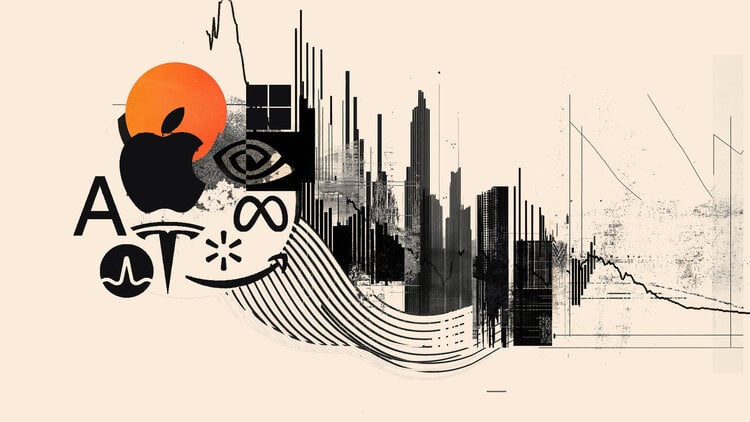Another wild session — and definitely not your classic Turnaround Tuesday tape. Stocks chopped around in a headline-driven mess, rattled by confirmation that the U.S. will go full tilt with a 104% tariff barrage on China starting Wednesday. That’s not posturing — that’s a freight train, and the market feels it.
The S&P 500 was up over 4% intraday — its biggest one-day jump since 2022 — only to fade hard into the close. This is the kind of market where extremes get faded fast. Volatility is now the main show, and if you bought the Monday flush and sold near today’s highs, congrats — that’s a career month, and you might have even made your year if you did it in size.
But let’s not pretend this is a stable foundation. These rallies are still built on a house of cards. Tape is fragile, conviction is thin, and we’re always one tariff headline away from another flush. Powell might be pretending he doesn’t need to get involved, but the market’s about to drag him in kicking and screaming. With vol this high, something in the system always breaks — it’s just a matter of where.
The yuan is the real tell. China has started a slow-motion devaluation, and it’s no longer subtle. The PBOC fix broke 7.20 for the first time since Trump took office — a Maginot Line for the currency, now in the rearview. We’re at 7.40 and counting, with 7.50 on every macro desk’s radar unless Beijing intervenes hard. And here’s the thing — they’re not selling dollars yet, but they’re also not stopping the bleed. That’s a message.
Why does it matter? Because China sits on $60 trillion in deposits, 3x the U.S., and if even a small slice of that heads for the exits, we’re not just talking about FX volatility. We’re talking capital flight, asset fire sales, and likely Asia, if not global contagion — the kind of stuff that hits hard
We’re still in the first-order effects phase: yuan down, equities down, Asia FX under pressure. But the second-order effects — capital outflows, forced deleveraging, regional FX repricing( currency war ?) — that’s where the real damage gets priced in.
So what now?
The market moves are crazy as there are far too many machines involved. Volatility is scorching. And it’s not over. For disciplined traders, this is a spaghetti-thrower’s paradise — provided you’re managing risk. For investors sitting on cash or duration, you’re in the rare position of waiting for the panic discount. Just remember: markets always overshoot in a mess. That’s what they do.
We’re back to pre-Covid PE multiples, but unlike the last bull run, we’re not riding on ultra-loose fiscal policy anymore. If you believe the fiscal squeeze is coming, then this tape isn’t cheap, especially when you factor in the stealth tax on earnings from tariffs.
My math says SPX 4500–4800 is where you start thinking about putting the investor hat back on. Until then? I’m still throwing spaghetti at the wall to see what sticks — just doing it with a tight leash and tighter stops.
It’s a trader’s tape right now. Keep it tactical, stay liquid, and don’t fall in love with any position.
Ever wonder why China pushed the IMF to stop publishing its ‘Reserve Adequacy’ stats for the mainland and Hong Kong back in 2019? Because the truth was getting uncomfortable. The optics don’t lie — China might now have the USD reserves to fully backstop its economy if the current account or capital flows go sideways.
Fast-forward to now, and it’s game on:
CNY and HKD are about to get jiggy.
Devaluation risk isn’t just theoretical anymore — it’s creeping into the fix. And with USD strength vs Aisa FX , capital flight pressure, and a trade war cranking higher, this could spiral into a real pain trade for anyone holding Chinese assets.
Buckle up — once reserve adequacy is in doubt, liquidity confidence can crack fast.
The view
Balancing tariffs is one thing — but in a true free-market system, there shouldn’t be tariffs at all. What we’re witnessing now isn’t strategic trade recalibration; it’s a completely avoidable policy error. Last week’s tariff rollout was, by any measure, a category-five mistake. And the wrecking ball doesn’t seem to be slowing. Even Elon Musk is calling out Navarro directly, backing a zero-tariff framework as the smarter path forward. A true free-trade zone would keep the U.S. as the dominant buyer while stabilizing global supply chains under clearer, rules-based conditions. Instead, we’ve been handed a muddled mess, crafted by people who either skipped calculus or shouldn’t have been near a policy lever to begin with. The current volatility isn’t the disease — it’s a symptom. This market doesn’t just need stabilization — it needs a new operating manual, and far better hands on the wheel.

